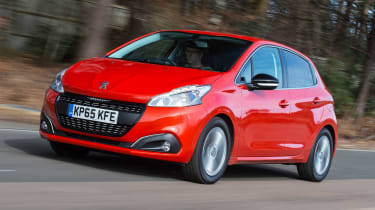
Peugeot has a strong pedigree when it comes to small cars, and the 208 is the latest of the breed. Its sharp looks inside and out, carved out from the similarly sporty appearances of other contemporary Peugeots, help it stand out in the crowded supermini market. It also rides well, so there is some substance to go with that style.
The latest 208 isn’t perfect though – interior space is a little compromised in the rear and it doesn’t have the biggest boot we’ve ever seen in a five-door supermini. It’s also more expensive than some of its key rivals, but the 208 does offer buyers a decent level of choice, with three trim levels and a spread of petrol and diesel engines, plus a fully-electric version, too.
About the Peugeot 208
Peugeot has some terrific small cars in its back catalogue, most notably the 205 which was a huge success across Europe in the 1980s and ‘90s. The company went off the boil a bit thereafter, and although it’s produced respectable numbers of subsequent cars, there’s been nothing that’s hit the spot in quite the same way. Part of the problem has been a lack of design flair, which Peugeot has done a lot to address in recent years.
The new focus on style really came to the fore in 2016 when Peugeot introduced the second-generation 3008 SUV, which effectively redefined its design language. Follow-up models have included the glamorous 508 fastback and the fashionable 2008 compact SUV, both of which have won plaudits for their style, upmarket feel and pleasant driving characteristics.
More reviews
Car group tests
In-depth reviews
Road tests
Used car tests
But it’s the supermini sector where Peugeot really had to get serious. It’s a core battleground for the French marque, and one of the toughest around with a range of excellent rivals that include the Ford Fiesta, Volkswagen Polo and resurgent Renault Clio. Peugeot knew it had a fight on its hands, and to its credit the latest 208 has the chops to take the fight to all of them.
Mixing with the best is one thing, but beating them is another, and it’s a big ask for Peugeot to return from the fight as a champion. Peugeot needed to ensure that comfort and refinement, decent driving dynamics, strong efficiency and plenty of technology were all present in the 208 if it truly wanted to shake up the supermini sector, and in many respects it has succeeded.
The 208 range consists of three trim levels. Entry-level cars are now badged Active Premium+, while the mid-range model is the Allure Premium+. The range-topper is the sporty looking GT version.
As for propulsion, the petrol range is built around the venerable 1.2-litre PureTech three-cylinder engine, with turbocharged versions and models with automatic transmission available. Diesel versions of the 208 are in shorter supply, as there’s just one version now offered. The 1.5-litre BlueHDi engine is a four-cylinder diesel powertrain mated exclusively to a six-speed manual gearbox.
If you’re looking into the 208, there’s a very strong chance that it’s the pure-electric version of the car that has piqued your interest. At the time of writing, the Peugeot e-208 is in a bit of a transitional phase. The firm has announced a revised version of its electric powertrain, boasting greater battery capacity and more power, in turn increasing the small electric car’s official range, but the updated version isn’t on sale just yet.
Used and nearly new
The timeline of the Peugeot 208 begins back in 2012, and covers two generations at the time of writing. Both models have affordable running costs to their name and prices have been kept in check by their popularity, although the 208 Mk2’s improvements over the Mk1 model in areas like interior quality and equipment make it a more desirable and therefore more expensive buy. It’s currently too early in the 208 Mk2’s lifecycle to ascertain its long-term durability, but there can be some reliability concerns with the Peugeot 208 Mk1.
Peugeot 208 history

Peugeot 208 Mk2: 2019-present
Rather than naming its new-gen supermini the 209, Peugeot decided to instead do a second generation of 208. The similarities go beyond the name, too: like its predecessor, the 208 Mk2 has a distinctive design and a broad selection of engines – including an array of petrols, a frugal diesel and for the first time on the Peugeot 208, a fully electric option. Unlike the 208 Mk1, the Peugeot 208 Mk2 is only available as a five-door hatchback, and the second-gen 208’s more premium billing meant it was a bit more expensive than the first-gen model.

Peugeot 208 Mk1: 2012-2019
The Mk1 208 was a capable all-round supermini when new, and was a noticeable improvement over its predecessor, the Peugeot 207. Despite being shorter than the 207, the Peugeot 208 Mk1 was actually a bit roomier for passengers, and the car looked quite stylish inside and out. All Peugeot 208 Mk1s came with the more minimalist i-Cockpit dashboard design that debuted on this model, and most versions were well equipped, though bear in mind entry-level cars didn’t get a touchscreen display or Apple CarPlay and Android Auto smartphone connectivity. Read our full Mk1 Peugeot 208 buyer’s guide here…
For an alternative review of the Peugeot 208, visit our sister site carbuyer.co.uk…




